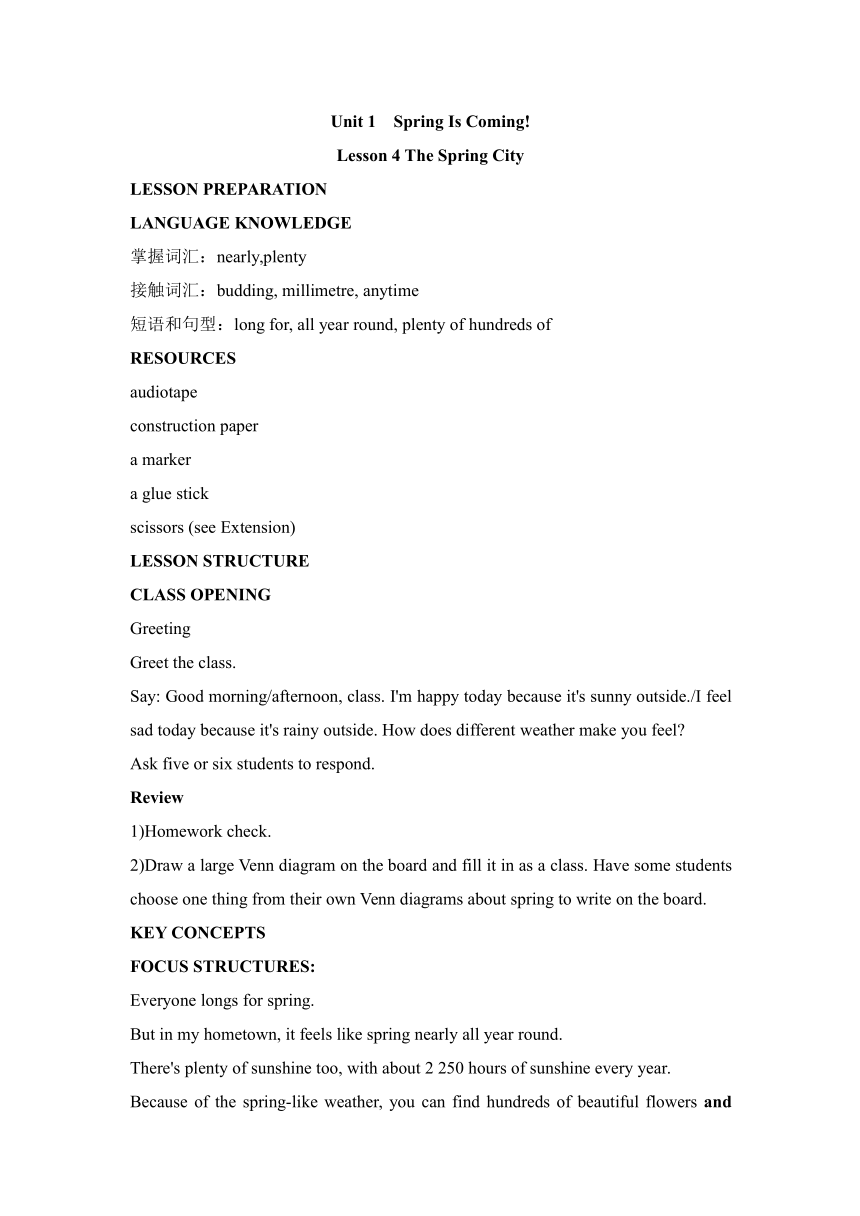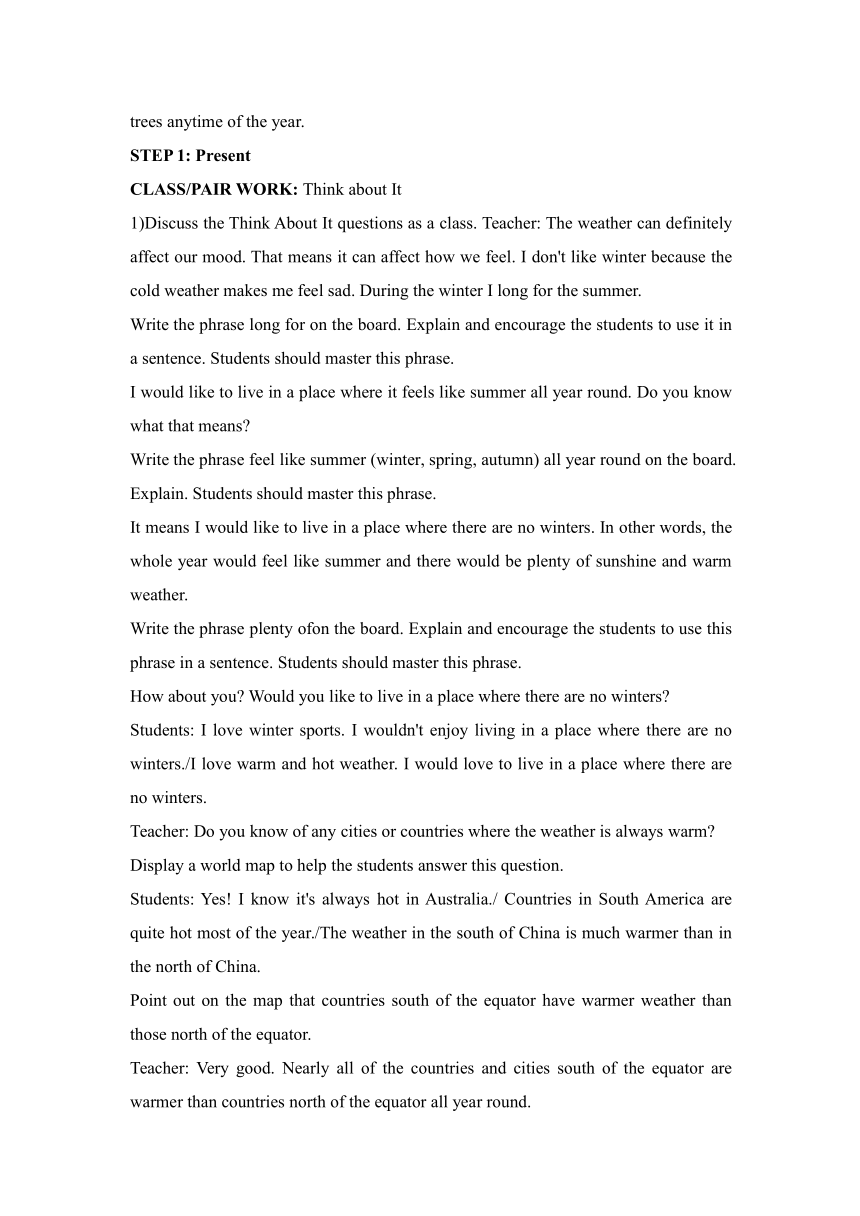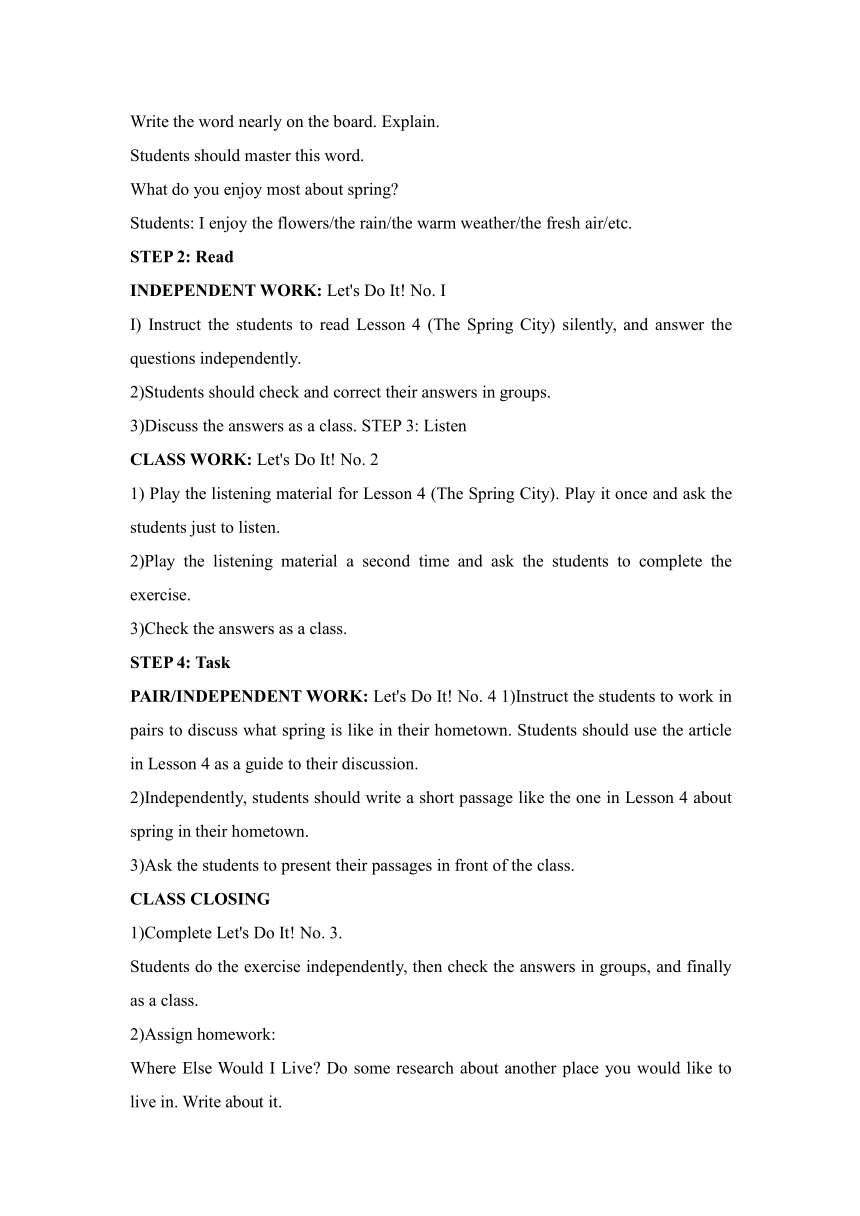Unit 1 Spring Is Coming! Lesson4教学设计冀教版八年级下册
文档属性
| 名称 | Unit 1 Spring Is Coming! Lesson4教学设计冀教版八年级下册 |  | |
| 格式 | docx | ||
| 文件大小 | 39.3KB | ||
| 资源类型 | 教案 | ||
| 版本资源 | 冀教版 | ||
| 科目 | 英语 | ||
| 更新时间 | 2024-12-19 19:30:00 | ||
图片预览



文档简介
Unit 1 Spring Is Coming!
Lesson 4 The Spring City
LESSON PREPARATION
LANGUAGE KNOWLEDGE
掌握词汇:nearly,plenty
接触词汇:budding, millimetre, anytime
短语和句型:long for, all year round, plenty of hundreds of
RESOURCES
audiotape
construction paper
a marker
a glue stick
scissors (see Extension)
LESSON STRUCTURE
CLASS OPENING
Greeting
Greet the class.
Say: Good morning/afternoon, class. I'm happy today because it's sunny outside./I feel sad today because it's rainy outside. How does different weather make you feel
Ask five or six students to respond.
Review
1)Homework check.
2)Draw a large Venn diagram on the board and fill it in as a class. Have some students choose one thing from their own Venn diagrams about spring to write on the board.
KEY CONCEPTS
FOCUS STRUCTURES:
Everyone longs for spring.
But in my hometown, it feels like spring nearly all year round.
There's plenty of sunshine too, with about 2 250 hours of sunshine every year.
Because of the spring-like weather, you can find hundreds of beautiful flowers and trees anytime of the year.
STEP 1: Present
CLASS/PAIR WORK: Think about It
1)Discuss the Think About It questions as a class. Teacher: The weather can definitely affect our mood. That means it can affect how we feel. I don't like winter because the cold weather makes me feel sad. During the winter I long for the summer.
Write the phrase long for on the board. Explain and encourage the students to use it in a sentence. Students should master this phrase.
I would like to live in a place where it feels like summer all year round. Do you know what that means
Write the phrase feel like summer (winter, spring, autumn) all year round on the board. Explain. Students should master this phrase.
It means I would like to live in a place where there are no winters. In other words, the whole year would feel like summer and there would be plenty of sunshine and warm weather.
Write the phrase plenty ofon the board. Explain and encourage the students to use this phrase in a sentence. Students should master this phrase.
How about you Would you like to live in a place where there are no winters
Students: I love winter sports. I wouldn't enjoy living in a place where there are no winters./I love warm and hot weather. I would love to live in a place where there are no winters.
Teacher: Do you know of any cities or countries where the weather is always warm
Display a world map to help the students answer this question.
Students: Yes! I know it's always hot in Australia./ Countries in South America are quite hot most of the year./The weather in the south of China is much warmer than in the north of China.
Point out on the map that countries south of the equator have warmer weather than those north of the equator.
Teacher: Very good. Nearly all of the countries and cities south of the equator are warmer than countries north of the equator all year round.
Write the word nearly on the board. Explain.
Students should master this word.
What do you enjoy most about spring
Students: I enjoy the flowers/the rain/the warm weather/the fresh air/etc.
STEP 2: Read
INDEPENDENT WORK: Let's Do It! No. I
I) Instruct the students to read Lesson 4 (The Spring City) silently, and answer the questions independently.
2)Students should check and correct their answers in groups.
3)Discuss the answers as a class. STEP 3: Listen
CLASS WORK: Let's Do It! No. 2
1) Play the listening material for Lesson 4 (The Spring City). Play it once and ask the students just to listen.
2)Play the listening material a second time and ask the students to complete the exercise.
3)Check the answers as a class.
STEP 4: Task
PAIR/INDEPENDENT WORK: Let's Do It! No. 4 1)Instruct the students to work in pairs to discuss what spring is like in their hometown. Students should use the article in Lesson 4 as a guide to their discussion.
2)Independently, students should write a short passage like the one in Lesson 4 about spring in their hometown.
3)Ask the students to present their passages in front of the class.
CLASS CLOSING
1)Complete Let's Do It! No. 3.
Students do the exercise independently, then check the answers in groups, and finally as a class.
2)Assign homework:
Where Else Would I Live Do some research about another place you would like to live in. Write about it.
Why would you want to live there
What can you do there
What is different about this place from where you live now
How would your life be different
EXTENSION
CLASS WORK: Diagraph Garden
Create a Diagraph Garden to review and practice vocabulary that uses the consonant diagraphs /th/, /sh/ and the vowel diagraph /ea/. Part of word building is learning to recognize the various graphemes within a word. A grapheme is the visual representation of a phoneme (the smallest unit of sound). Although we stress learning individual letter sounds, we often forget that there are 44 phonemes in the English language and only 26 letters.
In this activity, we will focus on two of the consonant digraphs: /th/, /sh/, and the two pronunciations for the vowel diagraph/ea/.
1)To start, you will need construction paper, a marker, a glue stick, and scissors.
2)Cut out your circle (for the centre of the flower) and five petals in 4 colors.
3)Write the consonant or vowel diagraph in the centre of each circle.
4)Tape 2 pieces of blue construction paper together and use a glue stick to place the stem at the centre of the flower.
5) Instruct the students to come up with a list of 5 words for each diagraph. Students may use their student books and/or a dictionary to help them make their word lists.
For example:
/th/ think thank through path math /sh/ sunshine shower short bush wash /ea/ [i:] beach season clean bean leave /ea/ [e] weather head instead spread feather
6) Have the students write the words for each diagraph on the same colour petals and glue them to the corresponding diagraph.
**Post the students'flowers up around the classroom. This is a good way to encourage students to be proud of their work and make the classroom beautiful and bright.
Sample diagraph flower
LANGUAGE NOTES
Everyone longs for spring.每个人都向往春天。 long for 意为“渴望,憧憬,向往”。
例如:
I long for a trip to the Cape of Good Hope.我渴望 到好望角去旅行。
They long for a mother's goodnight kiss.他们渴望 得到一个母亲道晚安时的亲吻。
2. But in my hometown, it feels like spring nearly all year round.但是在我的家乡,几乎全年都是春天的感觉。
feel like+名词,意为“感觉好像··,觉得好
像··”。feel like+物质名词,意为“摸起来好像是··”,feel like+doing=want to do意为 “想要做··”。例如:
It feels like rain soon.好像马上就要下雨了。 This stone feels like a potato.这块石头摸起来像土 豆。
I don't feel like eating today.今天我感觉不想吃饭。 3. There's plenty of sunshine too, with about 2 250 hours of sunshine every year.阳光也很充足,每年 大约有2250个小时的日照时间。
1)plenty of 意为“许多,大量”,后跟可数名词复数或不可数名词,与many, much, a lot of, lots of同义。例如:
I need plenty of ( a lot of lots of much)time to finish the work.我需要很多时间来完成这项工作。You can see plenty of ( a lot of lots of many) books on the shelf.你可以看到架子上有很多书。 2)with表示伴随状况。例如:
China is an ancient country, with a history of over five thousand years.中国是一个具有五千多年历史 的古国。
4. Because of the spring-like weather, you can find hundreds of beautiful flowers and trees anytime of the year.因为春天般的气候,你可以在一年中的任何时候都能看到数不清的美丽的花。
1)“because of+名词或代词”和“because”引 导的原因状语从句,都表示“因为···”。例如:I didn't go to school because I was ill. (because 导状语从句)因为生病,我没有去上学。
I didn't go to school because of my illness. (because of加名词性短语)因为生病,我没有去上学。
2)hundreds of意为“许许多多,数百的”。如果是具体的数字,hundred 后不加s。例如:
The farmer keeps hundreds of pigs on his farm.那 个农场主在农场里养了几百头猪。
The farmer keeps 6 hundred pigs on his farm.那个 农场主在农场里养了六百头猪。
==
Lesson 4 The Spring City
LESSON PREPARATION
LANGUAGE KNOWLEDGE
掌握词汇:nearly,plenty
接触词汇:budding, millimetre, anytime
短语和句型:long for, all year round, plenty of hundreds of
RESOURCES
audiotape
construction paper
a marker
a glue stick
scissors (see Extension)
LESSON STRUCTURE
CLASS OPENING
Greeting
Greet the class.
Say: Good morning/afternoon, class. I'm happy today because it's sunny outside./I feel sad today because it's rainy outside. How does different weather make you feel
Ask five or six students to respond.
Review
1)Homework check.
2)Draw a large Venn diagram on the board and fill it in as a class. Have some students choose one thing from their own Venn diagrams about spring to write on the board.
KEY CONCEPTS
FOCUS STRUCTURES:
Everyone longs for spring.
But in my hometown, it feels like spring nearly all year round.
There's plenty of sunshine too, with about 2 250 hours of sunshine every year.
Because of the spring-like weather, you can find hundreds of beautiful flowers and trees anytime of the year.
STEP 1: Present
CLASS/PAIR WORK: Think about It
1)Discuss the Think About It questions as a class. Teacher: The weather can definitely affect our mood. That means it can affect how we feel. I don't like winter because the cold weather makes me feel sad. During the winter I long for the summer.
Write the phrase long for on the board. Explain and encourage the students to use it in a sentence. Students should master this phrase.
I would like to live in a place where it feels like summer all year round. Do you know what that means
Write the phrase feel like summer (winter, spring, autumn) all year round on the board. Explain. Students should master this phrase.
It means I would like to live in a place where there are no winters. In other words, the whole year would feel like summer and there would be plenty of sunshine and warm weather.
Write the phrase plenty ofon the board. Explain and encourage the students to use this phrase in a sentence. Students should master this phrase.
How about you Would you like to live in a place where there are no winters
Students: I love winter sports. I wouldn't enjoy living in a place where there are no winters./I love warm and hot weather. I would love to live in a place where there are no winters.
Teacher: Do you know of any cities or countries where the weather is always warm
Display a world map to help the students answer this question.
Students: Yes! I know it's always hot in Australia./ Countries in South America are quite hot most of the year./The weather in the south of China is much warmer than in the north of China.
Point out on the map that countries south of the equator have warmer weather than those north of the equator.
Teacher: Very good. Nearly all of the countries and cities south of the equator are warmer than countries north of the equator all year round.
Write the word nearly on the board. Explain.
Students should master this word.
What do you enjoy most about spring
Students: I enjoy the flowers/the rain/the warm weather/the fresh air/etc.
STEP 2: Read
INDEPENDENT WORK: Let's Do It! No. I
I) Instruct the students to read Lesson 4 (The Spring City) silently, and answer the questions independently.
2)Students should check and correct their answers in groups.
3)Discuss the answers as a class. STEP 3: Listen
CLASS WORK: Let's Do It! No. 2
1) Play the listening material for Lesson 4 (The Spring City). Play it once and ask the students just to listen.
2)Play the listening material a second time and ask the students to complete the exercise.
3)Check the answers as a class.
STEP 4: Task
PAIR/INDEPENDENT WORK: Let's Do It! No. 4 1)Instruct the students to work in pairs to discuss what spring is like in their hometown. Students should use the article in Lesson 4 as a guide to their discussion.
2)Independently, students should write a short passage like the one in Lesson 4 about spring in their hometown.
3)Ask the students to present their passages in front of the class.
CLASS CLOSING
1)Complete Let's Do It! No. 3.
Students do the exercise independently, then check the answers in groups, and finally as a class.
2)Assign homework:
Where Else Would I Live Do some research about another place you would like to live in. Write about it.
Why would you want to live there
What can you do there
What is different about this place from where you live now
How would your life be different
EXTENSION
CLASS WORK: Diagraph Garden
Create a Diagraph Garden to review and practice vocabulary that uses the consonant diagraphs /th/, /sh/ and the vowel diagraph /ea/. Part of word building is learning to recognize the various graphemes within a word. A grapheme is the visual representation of a phoneme (the smallest unit of sound). Although we stress learning individual letter sounds, we often forget that there are 44 phonemes in the English language and only 26 letters.
In this activity, we will focus on two of the consonant digraphs: /th/, /sh/, and the two pronunciations for the vowel diagraph/ea/.
1)To start, you will need construction paper, a marker, a glue stick, and scissors.
2)Cut out your circle (for the centre of the flower) and five petals in 4 colors.
3)Write the consonant or vowel diagraph in the centre of each circle.
4)Tape 2 pieces of blue construction paper together and use a glue stick to place the stem at the centre of the flower.
5) Instruct the students to come up with a list of 5 words for each diagraph. Students may use their student books and/or a dictionary to help them make their word lists.
For example:
/th/ think thank through path math /sh/ sunshine shower short bush wash /ea/ [i:] beach season clean bean leave /ea/ [e] weather head instead spread feather
6) Have the students write the words for each diagraph on the same colour petals and glue them to the corresponding diagraph.
**Post the students'flowers up around the classroom. This is a good way to encourage students to be proud of their work and make the classroom beautiful and bright.
Sample diagraph flower
LANGUAGE NOTES
Everyone longs for spring.每个人都向往春天。 long for 意为“渴望,憧憬,向往”。
例如:
I long for a trip to the Cape of Good Hope.我渴望 到好望角去旅行。
They long for a mother's goodnight kiss.他们渴望 得到一个母亲道晚安时的亲吻。
2. But in my hometown, it feels like spring nearly all year round.但是在我的家乡,几乎全年都是春天的感觉。
feel like+名词,意为“感觉好像··,觉得好
像··”。feel like+物质名词,意为“摸起来好像是··”,feel like+doing=want to do意为 “想要做··”。例如:
It feels like rain soon.好像马上就要下雨了。 This stone feels like a potato.这块石头摸起来像土 豆。
I don't feel like eating today.今天我感觉不想吃饭。 3. There's plenty of sunshine too, with about 2 250 hours of sunshine every year.阳光也很充足,每年 大约有2250个小时的日照时间。
1)plenty of 意为“许多,大量”,后跟可数名词复数或不可数名词,与many, much, a lot of, lots of同义。例如:
I need plenty of ( a lot of lots of much)time to finish the work.我需要很多时间来完成这项工作。You can see plenty of ( a lot of lots of many) books on the shelf.你可以看到架子上有很多书。 2)with表示伴随状况。例如:
China is an ancient country, with a history of over five thousand years.中国是一个具有五千多年历史 的古国。
4. Because of the spring-like weather, you can find hundreds of beautiful flowers and trees anytime of the year.因为春天般的气候,你可以在一年中的任何时候都能看到数不清的美丽的花。
1)“because of+名词或代词”和“because”引 导的原因状语从句,都表示“因为···”。例如:I didn't go to school because I was ill. (because 导状语从句)因为生病,我没有去上学。
I didn't go to school because of my illness. (because of加名词性短语)因为生病,我没有去上学。
2)hundreds of意为“许许多多,数百的”。如果是具体的数字,hundred 后不加s。例如:
The farmer keeps hundreds of pigs on his farm.那 个农场主在农场里养了几百头猪。
The farmer keeps 6 hundred pigs on his farm.那个 农场主在农场里养了六百头猪。
==
同课章节目录
- Unit 1 Spring Is Coming
- Lesson 1 How's the weather?
- Lesson 2 It's Getting Warmer!
- Lesson 3 Sun Is Rising
- Lesson 4 The Spring City
- Lesson 5 Babysitting on a Spring Day
- Lesson 6 Stories about Spring
- Unit 2 Plant a Plant
- Lesson 7 Planting Trees
- Lesson 8 Why Are Plants Important?
- Lesson 9 Gardening with Mary
- Lesson 10 Make Your Garden Grow!
- Lesson 11 Amazing Plants
- Lesson 12 Danny's Plant
- Unit 3 Animals Are Our Friends
- Lesson 13 Danny's Big Scare
- Lesson 14 Amazing Animals
- Lesson 15 The Zoo Is Open
- Lesson 16 The Pear Escaped
- Lesson 17 Save the Tigers
- Lesson 18 Friendship Between Animals
- Unit 4 The Internet Connects Us
- Lesson 19 How Do You Use the Internet?
- Lesson 20 A Computer Helps!
- Lesson 21 Books or Computers?
- Lesson 22 Travel on the Internet
- Lesson 23 The Internet--Good or Bad?
- Lesson 24 An E-mail to Grandpa
- Unit 5 Buying and Selling
- Lesson 25 Raising Money
- Lesson 26 Cookies, Please!
- Lesson 27 Business English
- Lesson 28 Ms. Liu's Great Idea
- Lesson 29 How to Push a Product
- Lesson 30 A Cookie Sale
- Unit 6 Be a Champion!
- Lesson 31 Don't Fall, Danny
- Lesson 32 My Favourite Record
- Lesson 33 2800 Years of Sports
- Lesson 34 Modern Olympics
- Lesson 35 The Dream Team
- Lesson 36 Classroom Olympics
- Unit 7 Know Our World
- Lesson 37 Let's Learn Geography!
- Lesson 38 The World Is a Big Place
- Lesson 39 Ring Up or Call?
- Lesson 40 Body Language
- Lesson 41 A Class of the World
- Lesson 42 North America
- Unit 8 Save Our World
- Lesson 43 Let's Clean Up!
- Lesson 44 Environment Clubs
- Lesson 45 Let's Sort Garbage!
- Lesson 46 Protect Our Environment
- Lesson 47 Connected to Nature
- Lesson 48 Garbage Is Interesting!
